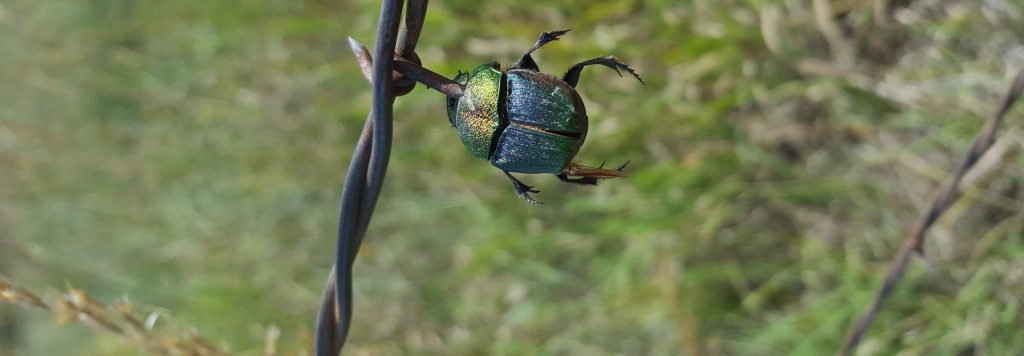By: Sierra Crumbaker
(Colorado Natural Heritage Program)
Ever come across a barbed wire fence decorated with the impaled bodies of insects, reptiles, rodents, and the occasional small bird? It looks like the work of a sadistic little kid having a boring day, but in fact it’s the proud display of what you might call nature’s little serial killer, the loggerhead shrike (Lanius ludocivians).

A loggerhead shrike and its unlucky prey. (Photo credit: David Leatherman)
Believe it or not, this songbird is infamous for its habit of catching and impaling other small creatures to whatever pointy object it has handy. If you google loggerhead shrike prey, you’ll be bombarded with images of beetles, grasshoppers, mice, lizards, and birds (sometimes decapitated) stuck to barbed wire, thorns, yucca, and sharp sticks.
Pam Smith, a resident botanist at CNHP, attended an indoor and outdoor Audubon field class about the loggerhead shrike led by David Leatherman, a retired Colorado State Forest Service entomologist and shrike enthusiast. They traveled to the plains of Weld County to respectfully examine the work of a local shrike, dubbed “Charles Manson” by Leatherman. He proceeded to explain that the work of Charlie has a lot less to do with psychopathic nature and a lot more to do with attracting females, who would pass through the area a little later. The impaling hobbies of a male shrike are intended to showcase his impressive talents to potential mates, and his stashes of speared buffets provide food for the couple and their young down the road.
To rub salt in the wound, shrikes frequently impale bugs head-first so that they remain alive and fresh for forthcoming meals, a strategy that has led Leatherman to discover pinned bugs with their legs still squirming. Leatherman also pointed out that shrikes not only behead some birds but place the head at one end of their nesting ground and the body at the other—what he believes may be an intimidation tactic in staking out territory.

According to Leatherman, this is a “rainbow scarab (Phaeneus vindex), a ‘bauble’ that males use to attract females when they newly migrate back north and are setting up breeding territories.” This one was found in southwestern Nebraska around September. (Photo Credit: Alyssa Meier)
The next time you’re out in the grasslands east of Fort Collins and you happen across a grasshopper impaled on a yucca, stop and listen, because you might hear the rough, squeaky melody of the little songbird responsible for it. And the next time you glance at CNHP’s colorful logo, just remember that somewhere out of sight in the background, there’s a barbed wire fence with a smorgasbord of small, impaled animals waiting to be noticed.
If you’re interested in learning more, click here for a humorous (and somewhat macabre) article about the “butcher bird” by David Leatherman.
This article is part of mini series about five species/things in our logo that embodies the ecology, botany and zoology work CNHP is committed to.

- CNHP’s Logo Part 1: Bat an Eyelash, Blue Grama
- CNHP’s Logo Part 2: Nature’s Little Serial Killer, the Loggerhead Shrike
- CNHP’s Logo Part 3: Payson Lupine and Silvery Lupine
- CNHP’s Logo Part 4: Royalty in Decline, the Regal Fritillary
- CNHP’s Logo Part 5: Pinnacle of Rocky Mountain National Park, Longs Peak




